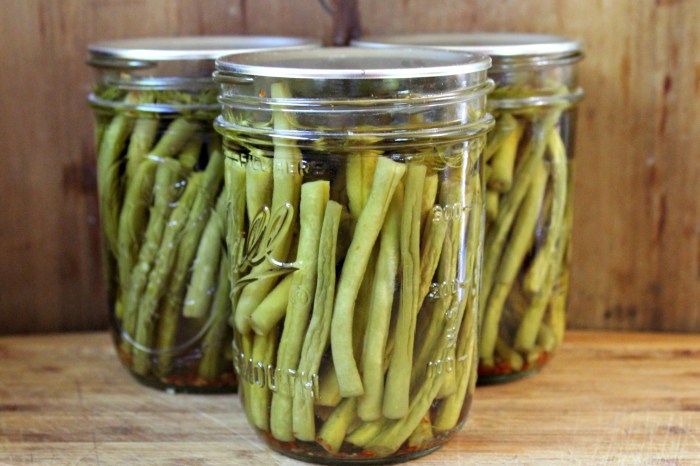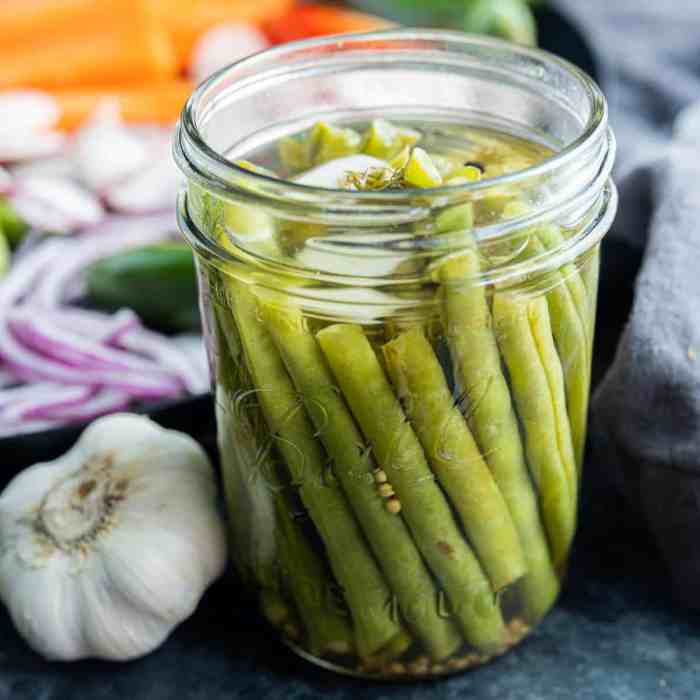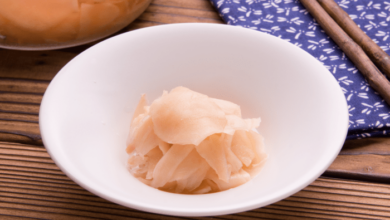
Crisp Pickled Green Beans: A Crunchy Delight
Crisp pickled green beans, a culinary treasure, are a testament to the art of preserving nature’s bounty. These crunchy, tangy delights have a rich history, spanning continents and cultures, and have found their way into kitchens worldwide. Their unique flavor profile, a delightful balance of sweet, sour, and salty, makes them a versatile addition to any meal, from salads and sandwiches to charcuterie boards and even cocktails.
From their humble beginnings in ancient pickling techniques to their modern-day popularity, crisp pickled green beans have evolved into a beloved staple. Their versatility shines through in their various culinary uses, offering a delightful crunch and a burst of flavor to countless dishes.
History and Origins

The art of preserving food through pickling has been practiced for centuries, with green beans being a popular choice for this method. The origins of pickling green beans can be traced back to various cultures around the world, each contributing unique techniques and flavor profiles.The practice of preserving food through pickling is believed to have originated in ancient Mesopotamia, where salt was used to preserve meat and fish.
This technique spread to other parts of the world, including Egypt, Greece, and Rome.
Traditional Methods of Pickling Green Beans
Pickling green beans has been a traditional method of preserving them in various cultures. Here are some examples:
- In China,green beans are often pickled in a brine made with salt, sugar, and spices, such as star anise, cloves, and ginger. The beans are then fermented for several weeks, resulting in a tangy and flavorful pickle.
- In Japan,green beans are pickled in a mixture of soy sauce, rice vinegar, and sugar. The beans are typically simmered in this brine until they become tender and slightly sweet.
- In the United States,green beans are often pickled in a vinegar brine with dill, garlic, and other spices. This method produces a crisp and refreshing pickle.
Historical Figures and Events
While specific historical figures associated with the development of crisp pickled green beans are not readily available, the evolution of pickling techniques is tied to advancements in food preservation and culinary practices. The development of vinegar production, the discovery of new spices, and the emergence of trade routes all contributed to the diversification of pickling methods and the popularity of pickled green beans.
Culinary Uses: Crisp Pickled Green Beans
Crisp pickled green beans, with their vibrant green hue, tangy flavor, and satisfying crunch, are a versatile ingredient that adds a delightful dimension to a wide array of culinary creations. They are a staple in many cuisines around the world, contributing both flavor and texture to dishes ranging from simple salads to elaborate entrees.
Uses in Various Cuisines
Pickled green beans find their place in diverse culinary traditions, adding a distinct character to each dish.
- American Cuisine:In the United States, crisp pickled green beans are often served as a side dish, accompanying barbeque, fried chicken, and other Southern favorites. They are also a popular ingredient in salads, sandwiches, and charcuterie boards.
- Asian Cuisine:In Asian cuisine, pickled green beans are used in a variety of dishes, including stir-fries, noodle dishes, and rice bowls. They add a refreshing and tangy element to these dishes, balancing the richness of the other ingredients.
- European Cuisine:In Europe, pickled green beans are a common ingredient in salads, especially in Germany and France. They are also used in various traditional dishes, such as sauerbraten, a German pot roast.
- Mediterranean Cuisine:In the Mediterranean region, pickled green beans are often used in salads, mezze platters, and as a topping for grilled meats and fish. Their tangy flavor complements the fresh, bright flavors of Mediterranean cuisine.
Recipes and Techniques
The unique flavor and texture of crisp pickled green beans lend themselves to a variety of culinary techniques.
Crisp pickled green beans are a delightful side dish, their tangy flavor adding a refreshing contrast to richer dishes. If you’re looking for a main course that would pair beautifully with these vibrant beans, I highly recommend trying out a loaded butternut squash cordon bleu.
The creamy, cheesy filling of the squash cordon bleu would be perfectly balanced by the crunchy, acidic bite of the pickled green beans, creating a symphony of textures and flavors.
- Salads:Pickled green beans add a delightful crunch and tangy flavor to salads. They can be combined with other vegetables, such as tomatoes, cucumbers, and onions, for a refreshing and flavorful salad.
- Sandwiches:Pickled green beans can be used as a filling for sandwiches, adding a tangy and crunchy element to the sandwich. They can be combined with other ingredients, such as cheese, ham, and turkey, for a flavorful and satisfying sandwich.
- Charcuterie Boards:Pickled green beans are a popular addition to charcuterie boards, adding a tangy and crunchy element to the board. They can be served alongside cured meats, cheeses, and other accompaniments.
- Stir-fries:Pickled green beans can be added to stir-fries to add a tangy and crunchy element to the dish. They can be combined with other vegetables, such as carrots, peppers, and onions, for a flavorful and satisfying stir-fry.
Types of Pickled Green Beans
There are various types of pickled green beans, each with its unique characteristics and common uses.
| Type | Characteristics | Common Uses |
|---|---|---|
| Dill Pickles | Crisp, tangy, and slightly sweet, with a distinct dill flavor. | Salads, sandwiches, charcuterie boards, and as a side dish. |
| Sweet Pickles | Crisp, tangy, and sweet, with a balance of vinegar and sugar. | Salads, sandwiches, charcuterie boards, and as a side dish. |
| Spicy Pickles | Crisp, tangy, and spicy, with a kick of chili pepper. | Salads, sandwiches, charcuterie boards, and as a side dish. |
| Garlic Pickles | Crisp, tangy, and garlicky, with a strong garlic flavor. | Salads, sandwiches, charcuterie boards, and as a side dish. |
Nutritional Value
Crisp pickled green beans, while offering a unique flavor profile, also provide a range of nutrients that contribute to overall health. Their nutritional composition varies depending on the pickling process and ingredients used, but generally, they offer a good source of vitamins, minerals, and fiber.
Nutritional Composition
Pickled green beans are a good source of vitamins, minerals, and fiber. They are low in calories and fat, making them a healthy choice for those watching their weight.
- Vitamins: Pickled green beans are a good source of vitamin K, which is essential for blood clotting and bone health. They also contain vitamin C, which is an antioxidant that helps protect cells from damage. Other vitamins present include vitamin A, folate, and thiamin.
- Minerals: Pickled green beans are a good source of minerals such as potassium, which helps regulate blood pressure, and magnesium, which is important for muscle function and nerve health. They also contain calcium, iron, and phosphorus.
- Fiber: Pickled green beans are a good source of dietary fiber, which helps regulate digestion and promotes satiety. Fiber also plays a role in maintaining healthy blood sugar levels and reducing cholesterol.
Comparison to Fresh Green Beans
While pickled green beans offer a unique flavor and texture, they may not be as nutrient-dense as fresh green beans. The pickling process can affect the nutritional content, as some vitamins and minerals may be lost during the fermentation or preservation process.
However, pickled green beans still provide a good source of certain nutrients.
Crisp pickled green beans are a classic side dish, but sometimes I crave something a bit creamier. That’s when I turn to an easy recipe for green beans with cream cheese, like the one I found on Cerita Kuliner.
It’s a simple, comforting dish that brings out the sweetness of the beans in a whole new way. And after indulging in that creamy goodness, I always appreciate the refreshing tang of a crisp pickled green bean even more.
Potential Health Benefits
Pickled green beans, due to their nutrient content, can contribute to overall health. Some potential benefits include:
- Improved Digestive Health: The fiber content in pickled green beans promotes regular bowel movements and helps prevent constipation.
- Stronger Bones: Vitamin K, a key nutrient in pickled green beans, is essential for blood clotting and bone health, reducing the risk of osteoporosis.
- Enhanced Immune Function: The vitamin C content in pickled green beans supports the immune system, protecting the body against infections and diseases.
- Reduced Risk of Chronic Diseases: The antioxidants in pickled green beans may help protect against chronic diseases such as heart disease, cancer, and diabetes.
Potential Risks, Crisp pickled green beans
While generally safe for consumption, pickled green beans may pose some health risks for certain individuals:
- High Sodium Content: Many pickled green beans are high in sodium due to the brine used in the pickling process. Excessive sodium intake can contribute to high blood pressure, especially for individuals with pre-existing conditions.
- Allergic Reactions: Some individuals may be allergic to vinegar or other ingredients used in the pickling process. Symptoms can range from mild to severe, and it is important to be aware of any potential allergies.
- Pregnancy and Breastfeeding: Pregnant and breastfeeding women should consult with their healthcare provider before consuming large quantities of pickled green beans, as some ingredients may not be safe for consumption during these periods.
Production and Processing

The transformation of fresh green beans into the crisp, tangy delights we know and love involves a series of meticulous steps, from harvesting to packaging. This process ensures the beans retain their vibrant color, crisp texture, and characteristic flavor.
Harvesting and Preparation
The journey begins with the selection of high-quality green beans. Farmers carefully harvest the beans at their peak ripeness, ensuring they are tender and flavorful. The beans are then thoroughly cleaned to remove any debris or impurities. This initial step lays the foundation for the final product.
Pickling Methods
The heart of the process lies in the pickling methods, which impart the characteristic flavor and texture to the green beans. There are three primary methods employed:
Brining
Brining involves submerging the green beans in a salt-based solution, typically a mixture of salt, water, and sometimes sugar. This method draws out moisture from the beans, creating a more tender texture. The salt also inhibits bacterial growth, preserving the beans for extended periods.
Crisp pickled green beans are a delightful side dish, their tangy flavor adding a bright contrast to rich, savory dishes. They’re particularly well-suited to complement the delicate flavors of a Chesapeake Bay stuffed rockfish , the flaky fish perfectly absorbing the briney goodness of the green beans.
Whether you’re enjoying a summer picnic or a cozy dinner at home, crisp pickled green beans are a versatile and refreshing addition to any meal.
Vinegar Pickling
Vinegar pickling, the most common method, utilizes a solution of vinegar, water, sugar, and spices. The acidic vinegar inhibits bacterial growth, while the sugar adds sweetness and depth of flavor. The green beans are submerged in this solution for a period of time, allowing the flavors to penetrate.
Fermentation
Fermentation is a less common method, involving the use of lactic acid bacteria to preserve the beans. This method results in a tangy, slightly sour flavor, and the beans develop a softer texture.
Packaging
Once the pickling process is complete, the green beans are carefully packaged to ensure their freshness and quality. They are typically packed in jars or other airtight containers, and the jars are often sealed with a vacuum to prevent spoilage.
The final product is then labeled with relevant information, such as ingredients, nutritional content, and storage instructions.
Flowchart of Crisp Pickled Green Bean Production
The production process can be visualized in a flowchart, illustrating the key stages:* Harvesting:Green beans are harvested at peak ripeness.
Cleaning
The beans are thoroughly cleaned to remove debris.
Blanching
The beans are briefly boiled to soften them and retain their vibrant color.
Pickling
The beans are submerged in a pickling solution, using one of the methods described above.
Packaging
The pickled beans are packaged in jars or other airtight containers.
Labeling
The jars are labeled with relevant information.
Storage
The packaged beans are stored in a cool, dry place.
Flavor Profile and Sensory Attributes
The flavor of crisp pickled green beans is a complex interplay of sweet, sour, and salty notes, with a distinct vegetal character that sets them apart from other pickled vegetables. The crisp texture adds to the sensory experience, making them a satisfying and refreshing snack or accompaniment to meals.
Flavor Components
The key flavor components that contribute to the distinct taste of crisp pickled green beans are:
- Acidity:Vinegar is the primary source of acidity in pickled green beans, providing a tangy and sharp flavor that balances the sweetness and saltiness. The type of vinegar used, such as white vinegar or apple cider vinegar, can influence the overall acidity and flavor profile.
- Sweetness:Sugar is added to the brine to balance the acidity and enhance the flavor. The amount of sugar used can vary depending on the recipe, but it typically results in a slightly sweet taste.
- Saltiness:Salt is essential for preserving the green beans and enhancing their flavor. It also helps to balance the sweetness and acidity, creating a harmonious taste profile.
- Vegetal Flavor:The green beans themselves contribute a distinct vegetal flavor that is both fresh and slightly earthy. This flavor is enhanced by the pickling process, which softens the beans and intensifies their natural flavors.
- Spice:Some recipes may include spices such as peppercorns, mustard seeds, or dill, which add complexity and depth to the flavor profile.
Sensory Attributes
Crisp pickled green beans offer a unique sensory experience that is both refreshing and satisfying. Their distinct flavor profile is complemented by their crisp texture, which provides a satisfying crunch.
- Texture:The crisp texture of pickled green beans is a key characteristic that distinguishes them from other pickled vegetables. The pickling process softens the beans while preserving their firmness, resulting in a satisfying crunch.
- Aroma:The aroma of pickled green beans is typically a combination of vinegar, sugar, and spices, depending on the recipe. This aroma is often described as tangy, sweet, and slightly pungent.
- Appearance:Crisp pickled green beans are typically bright green in color, with a slightly translucent appearance. They are often preserved in a brine that may be clear or slightly cloudy, depending on the recipe.
Flavor Profile Summary
The following table summarizes the flavor profile of crisp pickled green beans:
| Attribute | Description |
|---|---|
| Sweetness | Slightly sweet, balanced by the acidity and saltiness. |
| Acidity | Tangy and sharp, provided by the vinegar. |
| Saltiness | Moderate saltiness, enhances the flavor and balances the sweetness and acidity. |
| Vegetal Flavor | Fresh and slightly earthy, intensified by the pickling process. |
| Spice | May include peppercorns, mustard seeds, or dill, adding complexity and depth. |
Storage and Preservation
Crisp pickled green beans, with their vibrant flavor and satisfying crunch, are a delightful addition to any meal. However, maintaining their quality and freshness requires proper storage and preservation techniques. This section will explore the optimal storage conditions and different preservation methods to ensure your pickled green beans stay delicious for as long as possible.
Storage Conditions
Maintaining the quality and freshness of crisp pickled green beans requires proper storage. Ideally, they should be stored in a cool, dark, and dry environment. The refrigerator, with its consistent temperature, is the optimal storage location.
Preservation Methods
There are several methods for preserving pickled green beans, each with its own advantages and disadvantages.
Canning
Canning is a traditional method of preserving food by sealing it in jars and processing them in a boiling water bath. This method involves heating the pickled green beans to a high temperature, which kills bacteria and creates a vacuum seal that prevents spoilage.
Freezing
Freezing is another common method of preserving pickled green beans. This involves quickly freezing the beans at a temperature of 0°F (-18°C) or lower. Freezing preserves the flavor and texture of the beans, although they may become slightly softer after thawing.
Refrigeration
Refrigeration is a simple and effective method for short-term preservation of pickled green beans. Storing them in the refrigerator at a temperature of 40°F (4°C) or lower can extend their shelf life for several weeks.
Identifying Spoiled or Expired Pickled Green Beans
It’s important to be able to identify spoiled or expired pickled green beans to avoid consuming potentially harmful products. Here are some signs to look for:
- Off-odor:Spoiled pickled green beans may have a sour, rancid, or fermented smell.
- Discoloration:The beans may turn brown, gray, or have a slimy appearance.
- Mold growth:The presence of mold on the beans or in the brine is a clear indication of spoilage.
- Leaking brine:If the jar of pickled green beans leaks, it may indicate a broken seal or compromised contents.
Cultural Significance
Crisp pickled green beans, while seemingly simple, hold a place of significance in various cultures around the world. Their presence extends beyond a mere culinary element, often intertwined with traditions, customs, and even folklore.
Pickled Green Beans in Traditional Southern Cuisine
The American South has a deep-rooted love affair with pickled green beans. They are a staple in many Southern kitchens, often passed down through generations. The practice of preserving green beans through pickling emerged as a way to extend the harvest and enjoy the flavors of summer throughout the year.
This tradition is deeply embedded in Southern culture, reflecting the region’s agricultural heritage and resourceful approach to food preservation.
Pickled Green Beans in Eastern European Traditions
In Eastern Europe, particularly in countries like Poland and Russia, pickled green beans are a common sight on tables during special occasions and holidays. They are often served as part of a larger spread, alongside other pickled vegetables, meats, and breads.
Pickled green beans in these regions are often prepared with a combination of vinegar, sugar, and spices, resulting in a tangy and slightly sweet flavor.
Pickled Green Beans in Asian Cultures
In many Asian cultures, pickled green beans, often known as “pickled string beans,” are a popular condiment and side dish. These pickled beans are frequently prepared with a combination of soy sauce, rice vinegar, and ginger, resulting in a savory and umami-rich flavor profile.
They are often served alongside stir-fries, rice dishes, and noodles, adding a refreshing and tangy element to the meal.






